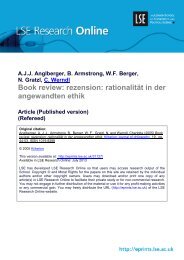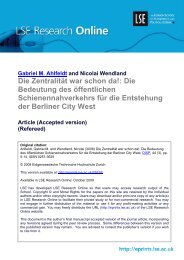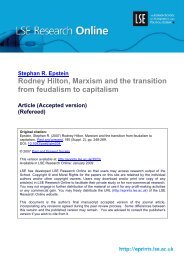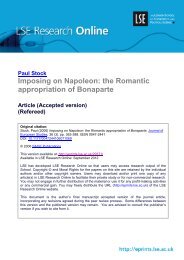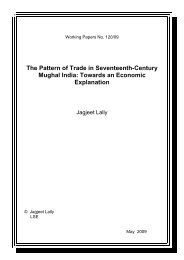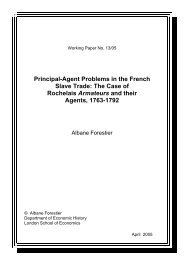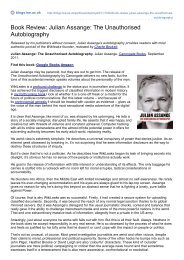Download (535Kb) - LSE Research Online - London School of ...
Download (535Kb) - LSE Research Online - London School of ...
Download (535Kb) - LSE Research Online - London School of ...
Create successful ePaper yourself
Turn your PDF publications into a flip-book with our unique Google optimized e-Paper software.
By Lemma 5.6 we have<br />
where<br />
and<br />
Um = ;Bm + Vm + e 1+<br />
m<br />
m<br />
Bm = m 1=2 ES1(2 ; ES2) ; m 1=2 (ES1) 2 (4.7)<br />
Vm = ;Z1(2 ; ES2)+ Z1Z2 + Z 2<br />
1<br />
m 1=2<br />
where >0and m denotes a remainder term. Set V 0 m = Vm + e 1+<br />
m . Thus<br />
By Lemma 6.3,<br />
+(2Z1 + Z2)ES1 (4.8)<br />
P (Um y) =P (V 0 m y + Bm): (4.9)<br />
sup P (V<br />
y2R<br />
0 m y) ; (y) ; m;1=2 (y)p(y) = o(e m): (4.10)<br />
It remains to derive an expansion for Bm. By Lemma 7.1, bearing in mind that (m=n) = O(m ;1=2 ),<br />
we have ES1 = (m=n) + o(m ;1 )+O(m ;1 ml) ES2 =1+o(m ;1=2 ) so that<br />
m 1=2 ES1 = qm + o(qm + m ;1=2 )+O(m ;1=2 ml) m 1=2 ES1(2 ; ES2) = qm + o(qm):<br />
If m = o(n 2 =(2 +1) ), then qm ! 0, and<br />
If m Kn 2 =(2 +1) , then qm K +1=2 ,andwe obtain<br />
(4.9) - (4.12) imply (2.13), (2.15) <strong>of</strong> Theorem 2.1.<br />
Bm = qm + o(qm + m ;1=2 )+O(m ;1=2 ml): (4.11)<br />
Bm = K +1=2 + o(1): (4.12)<br />
Pro<strong>of</strong> <strong>of</strong> Theorem 3.1. This follows the lines <strong>of</strong> that <strong>of</strong> Theorem 2.1. Relations (4.9), (4.10) remain<br />
valid. Recall that qm =(m=n) 2 m 1=2 , and under Assumption m, qm = O(1). To expand Bm we use<br />
(7.15) and (7.16) with k = 2 to deduce<br />
= e(1`2)=( c1<br />
c0<br />
Bm = qm + qm(m=n) 2 + o(m ;1=2 )+O(m ;1=2 ml) (4.13)<br />
) 2 2 `<br />
(<br />
9 2 )2 = d(1`4);e(1`2)e(2`2);e 2 (1`2) = c2<br />
c0<br />
4<br />
25 ;(c1<br />
c0<br />
) 2 22<br />
243<br />
where e(k ` ) and d(k ` ) are de ned in (7.5) and (7.17). If m = o(n 4=5 ), then qm = o(1)sothat<br />
Bm = qm + o(m ;1=2 )+O(m ;1=2 ml), and (3.13) follows from (4.9), (4.10). If m Kn 4=5 ,then<br />
(m=n) 2 K 5=2 m ;1=2 and thus Bm = K 5=2 + m ;1=2 K 5 + o(m ;1=2 )+O(m ;1=2 ml): Therefore<br />
from (4.9), (4.10) it follows that<br />
sup P (Um y) ; y + K<br />
y2R<br />
5=2 + m ;1=2 K 5 ; m ;1=2 (y + K 5=2 )p(y + K 5=2 )<br />
which implies (3.15).<br />
= o(m ;1=2 )+O(m ;1=2 ml)<br />
( `<br />
2 )4





